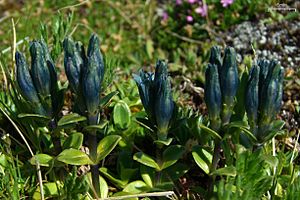Pale gentian facts for kids
Quick facts for kids Pale gentian |
|
|---|---|
 |
|
| Conservation status | |
| Scientific classification | |
| Genus: |
Gentiana
|
| Species: |
glauca
|
The Pale Gentian (Gentiana glauca) is a beautiful flowering plant. It belongs to the gentian family. People also call it the Glaucous Gentian. This plant grows naturally in eastern Asia and northwestern North America. You can find it from Alaska all the way to the Northwest Territories. It also grows in places like Washington and Montana.
Contents
About the Pale Gentian
What the Pale Gentian Looks Like
The Pale Gentian is a perennial herb. This means it's a plant that lives for more than two years. It grows a group of oval-shaped leaves close to the ground. This group of leaves is called a rosette. Each leaf is about 1 to 2 centimeters long. The plant also has leaves on its stem. These leaves grow directly opposite each other.
The stem of the Pale Gentian can grow up to about 15 centimeters tall. At the top of the stem, you'll find a cluster of flowers. This cluster is called an inflorescence. There are usually three to five flowers in each cluster. The flowers are a pretty blue or blue-green color. Each flower can be up to 2 centimeters long. After the flowers bloom, they turn into a fruit. This fruit is shaped like a tube and is called a capsule.
How the Pale Gentian Reproduces
The Pale Gentian can make new plants in two main ways. One way is by producing seeds. This is called sexual reproduction. The seeds grow inside the tubular fruit.
The plant can also spread in another way. It uses a special underground stem called a rhizome. New plants can sprout directly from this rhizome. This is a type of vegetative reproduction. It helps the plant spread and grow in new areas nearby.
Where the Pale Gentian Grows
This plant loves to grow in cold, open places. You can find it on the tundra. Tundra is a type of treeless plain. It also grows in other moist areas where there are no trees.
The Pale Gentian lives in high, cool places. These are called subalpine and alpine climates. Subalpine areas are just below the tree line. Alpine areas are above the tree line, where it's very cold. For example, in Montana, it grows at elevations around 2,485 meters high. In Alaska, you can find it at least 1,500 meters high.


